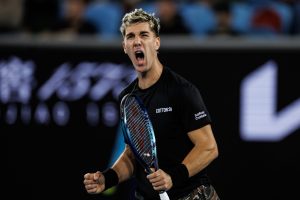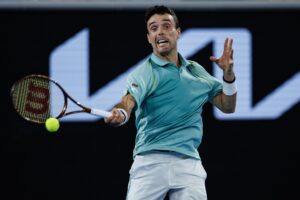Not long ago, at Wimbledon, Matteo Berrettini became the first Italian male tennis player to reach a Grand Slam final in 45 years. This performance came after a splendid run to the title at the Queen’s club championships. Lorenzo Musetti managed to take two sets off Novak Djokovic at the Roland Garros. Italy currently has ten men inside the top 100, second only to Spain. Taking a broader look, we see that many Italians are making their mark on the tour.
Rising star Jannik Sinner was on a roll at the Miami Masters, but lost to Hubert Hurkacz in the final. He also made the last 16 at Roland Garros. Lorenzo Sonego had an impressive run to the fourth round at Wimbledon, after finishing runner-up at Eastbourne. The Italian top five can be called the most dominant on tour after the Russians. All of them have contrasting styles of play that are suited to different surfaces. While Sinner has a game style that will benefit from the hard courts (though he so far excels on clay), Musetti has quite a few exceptional performances on clay courts, where his error count is low. The fast grass courts help Sonego, but he impresses on clay too. Berrettini can do well on all three surfaces owing to his brute power and strong serve.
Here we take a look at a few promising Italian tennis players.
Matteo Berrettini
ATP Rank: 8
Used to being the dark horse, the spotlight is something new for Matteo Berrettini. When teens Sinner and Musetti hogged the attention, Berrettini didn’t get the coverage he deserved. Now he is the Italian #1 and is credited with bringing more fans to the sport. In 2019, Berrettini reached the US Open semifinals. On the way, he overcame veteran Richard Gasquet and Andrey Rublev comfortably, before defeating an in-form Gael Monfils in a grueling match in the quarterfinals.
2020 was a quiet year for Berrettini, where he played just six tournaments in a curtailed season. He won his first title of 2021 at the Serbia Open, beating Aslan Karatsev in the final. He backed it up by making the finals at the Madrid Masters, losing narrowly to Alexander Zverev. At the French Open, he made the quarterfinals. Subsequently, he won the Queen’s Club Championships, his second title on grass. Then he made his march to the Wimbledon final.
Berrettini’s serve is the backbone that supports his highly aggressive style of play. His cracking serves–with pinpoint accuracy–allow him to dictate the game the way he does. At Wimbledon, he topped the leaderboard with the most aces in the tournament (117). The results were there for all to see as he made the final. His serves invariably kept saving break points, keeping him in strong position in matches. It’s his most important shot, which does half of the work for him, and his forehand does the rest.
There’s not much you can do other than meager defense when facing a forehand coming off one of the heaviest arms on tour. Looking at Wimbledon, it seems that no one except Djokovic, to a certain extent, managed to master his forehand–it was unstoppable. Berrettini uses a semi-western forehand grip that takes care of the topspin part. His power ensures that he can swat the forehand accurately from anywhere on the court to wherever he wants.
The second set of his Wimbledon semifinal against Hubert Hurkacz gave a glimpse of the degree of domination of Berrettini’s forehand. If he can keep playing at that level, no one will be able to stop him on any surface. Then the question arises, why isn’t he the best already? Well, the reason is, he often takes a set full of errors to gear up and get to that level, and sometimes even worse. Along with the most aces, Berrettini wasn’t far behind in the list of most unforced errors, which is never acceptable for Grand Slam contenders. Nevertheless, he will get better as time passes, and–it might be too early to say this–maybe crack the code of Majors. On his day, Berrettini will surely beat any player; it just has to come at the right time.
Jannik Sinner
ATP Rank: 23
Jannik Sinner was still scrapping through the ITF junior circuit when Roger Federer had already won his 20th Major. He turned pro in February 2018 and was ranked #551 at the end of the year, with no results fit to be called exceptional. Come 2019, Sinner won a couple of Challengers, becoming the youngest Italian to do so. He also won two ITF titles, besides making the main draw of the US Open, before collecting his first Tour-level win. He topped off a sensational year by sweeping the NextGen ATP Finals. Sinner finished the season at #78, after starting at #553.
By the end of 2020, Sinner had wins against top players; he also won his first ATP title at the Sofia Open, and made the quarterfinals at the French Open. So far this year, he has one ATP 250 title, a final appearance at the Miami Masters and Citi Open, and a quality outing at the French Open, where he made the last 16.
Sinner has a pinpoint-accurate bullet backhand which has his opponents running all over the court to fetch the ball. Consequently, he is always one step ahead, and the point carries on as Sinner desires. At only 19 years of age, it is admirable that his backhand is already considered one of the best in business. Sinner is blessed with great speed and puts a lot of spin on the shot. With a forehand that is as equally good if not better, he has no visible weak link in his game. Overall he has a clinical game, besides just a tinge of shakiness at the net.
Another x-factor that defines Jannik Sinner is his anticipation, which comes naturally to a select few. He plays an efficient game due to his high tennis intelligence and on-court awareness. Despite not being one of the best movers on the court, Sinner rarely makes an error that can be attributed to poor positioning, as he always reaches the ball at the right time. His skill goes a long way in saving stamina and allows him to play at a high level for longer durations. That being the case, Sinner is rarely the first to tire out in a match. The big three, among others, have heaped praise upon him since he played two of them.
A trend is starting to show in most of Sinner’s recent defeats, where he seems listless after losing a close first set. He loses focus; errors start creeping in, leading to his defeat. He must avoid giving away free points. For example, his match against Hubert Hurkacz in the Miami final, where he tapered off after narrowly losing the first set in the tiebreak. He likely could have won the match if there hadn’t been such a drop in his level. Apart from that, Sinner markedly struggles against good retrievers and counterpunchers, also becoming a bit predictable at times. Nevertheless, he will definitely iron out all the flaws and emerge as one of the NextGen greats. Sinner has a promising road ahead a few years in the future.
Lorenzo Sonego
ATP Rank: 26
Unlike the others, Lorenzo Sonego is no newcomer to the tennis world. Now at 26 years old, he has been around since 2016, when he played his first Tour-level match. In 2017, Sonego won his first Challenger tournament and made another final. Sonego collected his first Grand slam main draw victory against Robin Haase at the Australian Open 2018, before qualifying for the main draws of Wimbledon as well as the US Open that year.
In 2019, he transitioned from playing Challenger events to playing ATP Tour events regularly. He had good showings at 250 events and reached the quarterfinals at Monte-Carlo, also winning his first ATP title at the Antalya Open. All the while, his rank kept increasing steadily, and he started getting direct entries at ATP tournaments. In 2020, Sonego reached the fourth round of the rescheduled French Open. He also made the finals of the Vienna Open, where he lost to Andrey Rublev. Thus far in 2021, Sonego has one title win, another final, and a fourth-round appearance at Wimbledon.
Among tournaments where Sonego has posted good results, we see that almost all of them were on surfaces a bit on the faster side, excluding the 2020 French Open and 2021 Rome Masters. Sonego sometimes hits too flat to sustain on clay. Also, he struggles with movement on clay, leading to some badly-missed shots. The depth on his groundstrokes troubles opponents and is crucial to set up winners or force errors. But on clay, one short ball is all it takes for his opponent to pounce on the shot, which is toothless without the spin. He struggles against good defenders, who manage to exploit his clay weakness.
Sonego has done well on moderately quick courts at Melbourne and New York, and even better at Wimbledon. Most of his important titles and finals have come on hard courts–with the latest being on grass. Sonego hits groundstrokes flatter and deeper than the typical tennis player, instead of relying more on topspin. The power and depth of his shots make them harder to attack. He has impressive lateral court coverage and good defense. With his cracking forehand and accurate serve, fast courts are the perfect fit for him.
The highlight of Sonego’s career so far has to be his demolition of Novak Djokovic at Vienna Open, in a match where he lost just three games. Even though Djokovic was clearly not playing at his best, it is never easy to beat him, and Sonego deserves credit for his clever use of drop shots mixed up perfectly between big forehands. That night, Sonego was high on adrenaline, always ready to hit that extra shot, and covering the court excellently. He can challenge anyone with such a terrific game. However, we can see that Sonego doesn’t have a complete game, as he struggles on clay against the top guys. Though he is ranked #26, Sonego has room for improvement and will become one of the best if he adds another dimension to his game.
Lorenzo Musetti
ATP Rank: 62
An upcoming Italian with a handful of wins on the Challenger Tour made waves when he shocked Stan Wawrinka and Kei Nishikori in back-to-back matches at the 2020 Rome Masters. Lorenzo Musetti amazed everyone with his flashy groundstrokes and vigor on the court, and certainly looked one for the future. After his exit, he returned to the Challenger circuit to improve his ranking. Between Rome 2020 and the 2021 French Open, Musetti played ten Challenger tournaments, made three finals, and secured one title. He also entered the Mexican Open and the Barcelona Open, and fell in the semifinals to Stefanos Tsitsipas in both of them. Musetti rose from #280 to #76 in eight months and got a main draw entry to the French Open, where he had a dream run to the fourth round.
What sets Musetti apart on clay is his ability to produce spin and depth from defensive positions. He is very flexible on the backhand wing, as he can use it to keep grinding in the rally or whip it flat to slam winners. Musetti starts his backhand swing from a high position and brings it down, resulting in a prolonged motion. This technique, also followed by Dominic Thiem, allows him to add power and roll to his shot. Musetti likes to catch the ball early, making it easier for him to switch between a defensive topspin or an attacking backhand. Also, Musetti’s contact time with the ball is less, and his follow-through is brief. As a result, Musetti’s backhand looks very crisp and takes time away from the opponent.
Musetti still hasn’t carried his excellent form on clay to the faster hard courts, and grass courts are a distant dream right now. Despite all the hype, he didn’t do well at Wimbledon or the Olympics, with both played on quick surfaces. His game on quick surfaces is nowhere close to what it is like on clay. It isn’t wrong to say that Musetti doesn’t have charming footwork. Also, his strokes are flashy and swift, but not very solid. Understandably so, Musetti also struggles against big hitters and heavy-ballers. He becomes too vulnerable when forced to defend, and his backhand slice hardly serves as a weapon.
Although Musetti is ranked #62 and has hardly shown impressive results on other surfaces yet, his performance on clay shows his potential. At first glance, his game looks so good that he can defeat the best, which he almost did against Novak Djokovic at Roland Garros. However, from a player having such talent, better results are expected. His Wimbledon campaign ended disappointedly in a first-round defeat. Still, his results on the Acapulco hardcourts show that there is scope for his improvement and that he is not a single-surface master. Musetti has a long way to go before he becomes complete as a player, but he has ample time to do so, at only 19.
Honorable Mentions
Luca Nardi is another upcoming Italian, who turned adult a few days back. Nardi has played one tour-level match at the Antwerp ATP, where he managed to take a set off Marcus Giron. Nardi has a couple of ITF futures titles and is ranked #591 at the moment. Though these are performances are not up to the mark considering his competition, they are impressive for an average 18-year-old. It will be interesting to see how his career unfolds and if he can make it big.
Besides the young guys, Fabio Fognini deserves a special mention among the Italians. To date, Fognini remains the only man besides Stefanos Tsitsipas to have defeated Nadal after being two sets down. He achieved the feat at the US Open in 2015, in his third win over Nadal that year. At 34 years of age, even though past his prime, he still manages to make the headlines with good performances. Fognini indeed deserves credit for dragging Italian tennis through when no one else was.
Main Photo from Getty.






